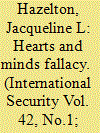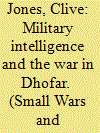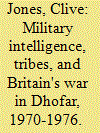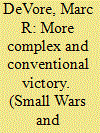|
|
|
Sort Order |
|
|
|
Items / Page
|
|
|
|
|
|
|
| Srl | Item |
| 1 |
ID:
153632


|
|
|
|
|
| Summary/Abstract |
Debates over how governments can defeat insurgencies ebb and flow with international events, becoming particularly contentious when the United States encounters problems in its efforts to support a counterinsurgent government. Often the United States confronts these problems as a zero-sum game in which the government and the insurgents compete for popular support and cooperation. The U.S. prescription for success has had two main elements: to support liberalizing, democratizing reforms to reduce popular grievances; and to pursue a military strategy that carefully targets insurgents while avoiding harming civilians. An analysis of contemporaneous documents and interviews with participants in three cases held up as models of the governance approach—Malaya, Dhofar, and El Salvador—shows that counterinsurgency success is the result of a violent process of state building in which elites contest for power, popular interests matter little, and the government benefits from uses of force against civilians.
|
|
|
|
|
|
|
|
|
|
|
|
|
|
|
|
| 2 |
ID:
132275


|
|
|
|
|
| Publication |
2014.
|
| Summary/Abstract |
This article examines the role military intelligence played in the Dhofar campaign between 1970 and 1976. Drawing on an array of sources, it examines not only the crucial role played by military intelligence in prosecuting a successful operational campaign against a Marxist inspired insurgency, but equally, the importance that intelligence played in consolidating the Al Bu Said dynasty when across Oman and Dhofar itself, the material benefits to be had from the discovery and production of oil had yet to be realised.
|
|
|
|
|
|
|
|
|
|
|
|
|
|
|
|
| 3 |
ID:
110343


|
|
|
|
|
| Publication |
2011.
|
| Summary/Abstract |
This article examines the hitherto overlooked role of military intelligence in the Dhofar campaign of 1970-1976. Drawing on an array of new sources, it not only details the functional role of military intelligence in the campaign, but also makes a distinction between "attitudinal" and "behavioral" support in understanding the "human terrain," and thereby how military intelligence helped secure acceptance of the regime of Sultan Qaboos bin Sa'id among the tribes of Dhofar.
|
|
|
|
|
|
|
|
|
|
|
|
|
|
|
|
| 4 |
ID:
109958


|
|
|
|
|
| Publication |
2012.
|
| Summary/Abstract |
Following the emergence of a communist regime in South Yemen and the multiplication of subversive movements in the United Kingdom's Gulf protectorates, British policymakers genuinely feared the spread of communism throughout southern Arabia. Defeating the People's Front for the Liberation for the Occupied Arabian Gulf (PFLOAG) insurgency in Oman's Dhofar province was considered central to preventing such an outcome. In their pursuit of victory, British officers overthrew the sultan of Oman, escalated the war by conducting attacks in South Yemen, and, ultimately, appealed to Islam as a means of rallying support against communism. However, lessons learned in previous counterinsurgencies (Malaya, Kenya, and Borneo) proved of only limited value in Oman's physical and cultural environment. Unfortunately, none of these measures worked as anticipated. Only Iran's direct military intervention and the dramatic growth of Oman's financial resources after the 1973 oil crisis provided the resources to conduct large-scale offensive operations. Even so, victory was only achieved in 1975 because the rebellion's leaders unwisely attempted to oppose the Anglo-Omani offensives conventionally.
|
|
|
|
|
|
|
|
|
|
|
|
|
|
|
|
|
|
|
|
|